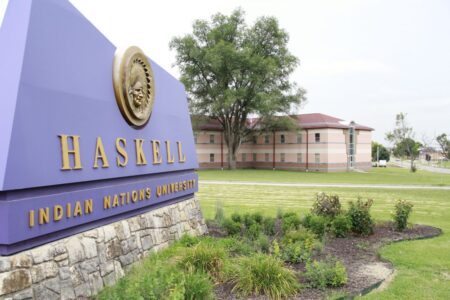Lawrence will have a partial view of upcoming total solar eclipse — the last total eclipse until 2044

3-year-old Kepler Fassnacht tries to get a look at the solar eclipse through protective eyewear at the Eclipse at KU event, Monday, Aug. 21, 2017, at Shenk Sports Complex.
In two weeks, parts of the U.S. will be in the visual path of a total solar eclipse — an event that won’t happen again until 2044.
The eclipse will be visible during the afternoon on Monday, April 8. According to the National Solar Observatory, an eclipse path will sweep across parts of Texas, Oklahoma, Arkansas, Missouri, Kentucky, Illinois, Ohio, Pennsylvania, New York, Vermont, New Hampshire and Maine, as well as central Mexico and southern Canada. It’ll be the first time an eclipse has crossed the U.S. since 2017.
Seven years ago, Lawrence was located very near the eclipse’s path of totality, the area where the moon fully obscures the sun. That meant that even under cloudy conditions, the sky had darkened enough by the peak of the eclipse at 1:09 p.m. to necessitate the use of streetlights and car headlights.

photo by: Kim Callahan/Journal-World Photo
Lights came on at Liberty Hall, 644 Massachusetts St., shortly after 1 p.m. Monday, Aug. 21, 2017, just as the solar eclipse hit its peak.
This time around, however, Lawrence is farther off that path. Jennifer Delgado, an associate teaching professor in the University of Kansas’ Department of Physics & Astronomy told the Journal-World that Lawrence should be able to see around 90% of the sun’s surface covered at its peak around 1:45 p.m.
While that may seem a high percentage, Delgado said it actually won’t even be noticeable to those who aren’t keeping an eye out. In fact, Delgado said that people who were unaware an eclipse was taking place would likely not even notice the difference.
“A few years back in 2017, Lawrence was in the 99% totality (range), so it didn’t actually get to totality,” Delgado said. “The sun is so immeasurably bright, even if you block (90% or 99%) of its light, you still basically have so much light coming at you, you don’t really notice anything.”
That doesn’t mean there won’t be visual indicators for people in Lawrence who are looking for them, though. Those viewing the eclipse through the proper eye protection — usually a pair of safe solar viewing “eclipse glasses,” or a telescope with the proper mirrored filter — will be able to see a “visible disc” as the moon blocks out a big portion of the sun, Delgado said.

photo by: Ashley Hocking/Lawrence Journal-World
University of Kansas students, from left, Jenny Warren, Lauren Anderson and Katy Winkle attempt to observe the solar eclipse using protective eyewear at the Eclipse at KU event, Monday, Aug. 21, 2017, at Shenk Sports Complex.
That’s a sight worth seeing, she said.
“You can actually see, it almost kind of looks like — near the greatest portion of the sun being blocked by the moon — it will almost look like the sun is itself a little crescent moon through your eclipse glasses,” Delgado said.
Seeing the eclipse at 100% totality, however, will require a bit of a road trip to the south, the east or some combination of both. Delgado said it’ll take a roughly five-hour drive to reach the path of totality from Lawrence, with the closest viable destinations being cities like Fayetteville and Little Rock in northwest Arkansas.

Staff from Edwards & Wilson Periodontics in Lawrence loaded up and traveled south to find a break in the clouds during the solar eclipse, Monday, Aug. 21, 2017.
Delgado said the best viewing experience either way is likely going to happen further south, where the duration of totality will be longer — but only by a matter of seconds. It’s also more likely to be sunny to the south at this time of year, she added.
At 100% totality, the eclipse will look vastly different compared to the peak overlap here in Lawrence, mainly in that it will darken mid-day as if it’s nighttime. Delgado said that also includes other phenomena, like an unobstructed view of the sun’s corona — the outermost part of the sun’s atmosphere — and a scattering of bird and insect calls usually heard only when the sun is setting.
“I would say it’s worth seeing,” Delgado said. “…It’s cool because you’re experiencing a sort of weird picture of where we really are in the universe — we’re on this ball orbiting the sun and the moon is … orbiting us.”
But for those simply looking out for a local view of part of the sun being blocked by the moon, Delgado said that should be visible just about any time during the window the eclipse is set to take place from 12:30 p.m. to 3 p.m.
Delgado encouraged people who plan to view the eclipse to use the proper protective eyewear, and also to make sure that their eclipse glasses aren’t a counterfeit product that won’t actually protect your eyes. Delgado said it’s easy to test eclipse glasses simply by shining a light on them. The American Astronomical Society notes that light sources like an LED bulb flashlight like those included with smartphones should appear quite dim through legitimate eclipse glasses.
People in Lawrence will be able to watch the eclipse as it happens on KU’s campus, as astronomers with KU’s Society of Physics Students chapter have planned a viewing event. From noon to 3:30 p.m. April 8, solar telescopes will be stationed at the marching band practice tarmac located west of the Dole Institute of Politics, 2350 Petefish Drive. Attendees will also get a free pair of eclipse glasses.

Leo Zhu attempts to observe the solar eclipse through a telescope during the Eclipse at KU event, Monday, Aug. 21, 2017, at Shenk Sports Complex.







COMMENTS